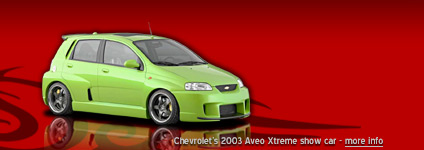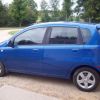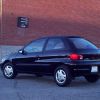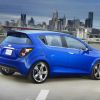Hello all! I am new to the forums here, but my wife and I have owned an '05 Chevy Aveo LS hatchback (1.6L, MT) since 2011. I'm currently troubleshooting an issue that has been present for some time now — the red brake system warning light on the dash is remaining on after the emergency/parking brake lever has been released.
This light has been on now for a little over a year, and I'm just now getting the time to troubleshoot it. A bit of background for sake of context might be helpful — the car has only 65,000 miles on it to date, and has had no significant issues since we've owned it. I performed a full four-wheel brake service 3.5 years (6,000 miles) ago, including the following:
- Replaced the front brake calipers, rotors, pads, and hoses
- Inspected, cleaned, and adjusted the rear drum brakes and parking brake
- Bled the entire brake system per repair manual procedure
I'm fairly convinced that this is somehow related to a faulty sensor or switch rather than indicating an actual fault in the braking system, in light of the brake system service performed only 6,000 miles ago and the below data points:
- The rear brake lights are functioning properly
- The car does not pull to one side or the other when braking
- The parking brake is used on a regular basis and is fully functional. It engages fully and is capable of holding the car still even on an incline, releases fully and does not drag, and has the expected impact on the DRL
- The brake fluid reservoir is full, ruling out low brake fluid as the culprit
- I've examined each wheel closely for signs of slow leaks from brake bleeders, lines, calipers, or wheel cylinders and have found none
- The brake system warning light is on steady as opposed to flashing intermittently
- There are no Check Engine Lights or ABS System warning lights showing on the dash
- I have used a ScanGauge E to scan for CEL's and fault codes, and it comes up empty
With all of the above in mind, I'm proceeding with the hypothesis that the warning light is being thrown by a faulty switch or sensor of some sort. I'm no rookie under the hood, but tracking down electrical gremlins has never been a strong suit.
I searched the forums here prior to posting but found only two related threads, one of which the cause turned out to be low brake fluid, while the other contained no listed resolution. After some additional searching online, I came across an article from Your Mechanic listing six possible causes. Hoping for an easy solution, I performed the following tests to no avail:
- Jiggled parking brake lever aggressively in the down position
- Used significant downward pressure to ensure parking brake lever was fully released
- Verified brake fluid reservoir fluid level
Pages 11–20 of the "Hydraulic Brakes" section of the Service Manual (attached) contain a Brake Warning System troubleshooting workflow. In the course of following it, I disconnected the wiring harness connector to the Brake Fluid Pressure Sensor located on the Brake Fluid Reservoir, and found that doing so turned off the warning light on the dash for about two cycles of the emergency brake, after which it resets.
This leads me to believe the Brake Fluid Pressure Sensor could be faulty. For those of you curious what this part looks like, it's available at Rock Auto for $18.88 + shipping, and Wikipedia has a brief write-up on how these sensors usually work.
Rather than work off of a hunch and risk simply throwing money and parts at the problem, I was hoping to find a way to definitively prove the switch was faulty. Additional research online turned up this YouTube video comment regarding the possibility of a float tied to said pressure sensor possibly getting stuck inside the reservoir. Unfortunately, no float is visible through the reservoir's cap, and I tried tapping the side of the reservoir with a screwdriver to no avail.
I then came across another YouTube video demonstrating how to test the switch via the continuity setting on a multimeter. I performed this test myself and found no continuity between the two pins on the sensor's electrical connector, which would appear to indicate the sensor is not my issue.
Before I start off on various wild electrical goose chases, is there anything simple I've overlooked to date? Anyone else have experience with this particular issue or a recommended way to test the brake fluid pressure sensor for proper operation?



 LinkBack URL
LinkBack URL About LinkBacks
About LinkBacks 2005 Chevrolet Aveo LS Hatchback
2005 Chevrolet Aveo LS Hatchback
 Reply With Quote
Reply With Quote My daily driver
My daily driver "Pre-Aveo"
"Pre-Aveo" Chevrolet's Aveo RS Concept
Chevrolet's Aveo RS Concept

